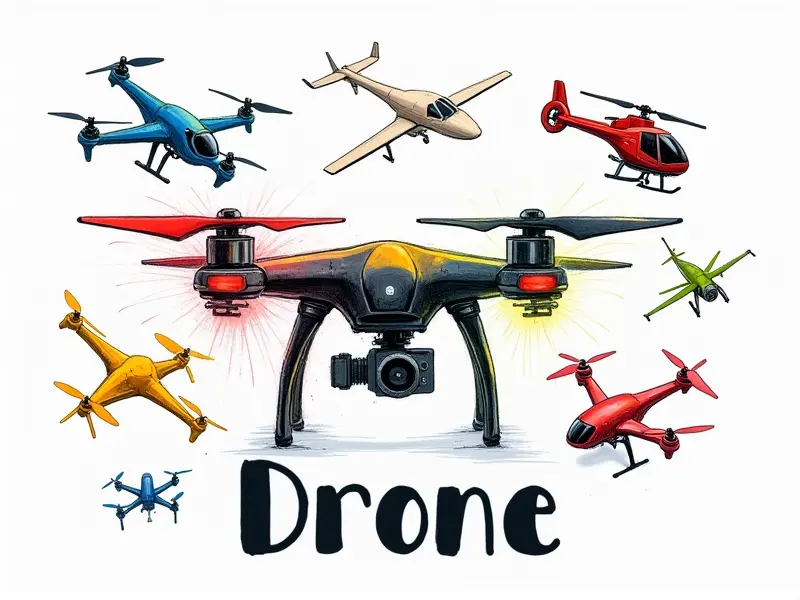Basic Arduino code for drones

Getting Started with Drone Coding in Arduino
Welcome to the world of drone programming using Arduino! This guide is designed to help you understand the basics and get started on your journey to building and controlling drones. Whether you're a beginner or an experienced hobbyist, this article will provide you with essential knowledge and practical examples to enhance your skills in drone development.
Essential Arduino Code for Drones Explained
To start coding for drones using Arduino, it's crucial to understand the fundamental components involved. The primary hardware includes a microcontroller board (Arduino), motors, ESCs (Electronic Speed Controllers), and sensors such as IMUs (Inertial Measurement Units). These components work together to control the drone's flight dynamics.
The basic structure of an Arduino program for drones involves initializing all necessary pins and libraries, setting up communication with the ESCs, and implementing flight control algorithms. Here’s a simple example:
#include <Servo.h>
Servo esc1;
Servo esc2;
Servo esc3;
Servo esc4;
void setup() {
esc1.attach(9);
esc2.attach(10);
esc3.attach(11);
esc4.attach(12);
// Initialize ESCs
}
void loop() {
// Control logic for drone flight
}
Beginner's Guide to Drone Programming with Arduino
If you're new to drone programming, it’s important to familiarize yourself with the basics of C++ and Arduino IDE. Start by setting up your development environment and installing necessary libraries such as PIDController for feedback control systems.
Setting Up Your Environment
- Install Arduino IDE: Download and install the latest version of the Arduino Integrated Development Environment (IDE).
- Select Board Type: Choose your specific Arduino board from the Tools > Board menu.
- Select COM Port: Ensure that your Arduino is connected to the correct serial port in the IDE.
Writing Your First Drone Code
Begin with simple scripts like controlling an LED or a motor. Once you're comfortable, move on to more complex tasks such as reading sensor data and implementing basic flight control algorithms.
Simple Arduino Scripts for RC Drones
One of the first steps in drone programming is learning how to interface with ESCs and motors. Here’s a simple script that initializes an ESC:
#include <Servo.h>
Servo esc;
int pin = 9;
void setup() {
esc.attach(pin);
}
void loop() {
for (int i=0; i<180; i++) {
esc.write(i);
delay(15);
}
}
Arduino Basics for Drone Enthusiasts
To dive deeper into drone programming, it’s essential to understand the role of various sensors and how they contribute to flight stability. Commonly used sensors include:
- IMU (Inertial Measurement Unit): Measures acceleration, angular velocity, and orientation.
- Magnetometer: Provides heading information based on Earth's magnetic field.
- Barometer: Detects altitude changes for precise vertical control.
Implementing Sensor Data in Code
Incorporating sensor data into your drone code is crucial for achieving stable and responsive flight. Libraries like I2Cdevlib can help you interface with these sensors easily:
#include <Wire.h>
#include "MPU6050.h"
MPU6050 accelgyro;
void setup() {
Wire.begin();
accelgyro.initialize();
// Initialize other components
}
void loop() {
if (accelgyro.getMotion6(&ax, &ay, &az, &gx, &gy, &gz)) {
// Process sensor data for flight control
}
}
Learn Arduino Coding for FPV Racing Drones
FPV racing drones require precise and responsive control systems. Implementing PID (Proportional-Integral-Derivative) controllers is crucial for achieving smooth and stable flight:
#include <PID_v1.h>
double Setpoint, Input, Output;
double Kp = 20, Ki = 5, Kd = 3;
// Create a PID object
PID myPID(&Input, &Output, &Setpoint, Kp, Ki, Kd, DIRECT);
void setup() {
// Initialize system and set up the PID controller
}
void loop() {
// Update input value from sensor data
Input = getSensorValue();
// Compute output based on PID control algorithm
myPID.Compute();
}
Quick Start Guide to Arduino Programming for Drones
This section provides a concise overview of the steps involved in creating your first drone project:
- Choose Your Components: Select appropriate motors, ESCs, and sensors.
- Set Up Your Arduino IDE: Install necessary libraries and configure your board settings.
- Write Basic Code: Start with simple scripts to control individual components.
- Integrate Sensors: Incorporate sensor data into your code for enhanced flight performance.
- Test and Iterate: Continuously test and refine your drone’s behavior based on real-world feedback.
Drone Control Using Basic Arduino Code
Controlling a drone involves managing multiple axes of movement (pitch, roll, yaw) and altitude. Here’s an example of how to implement basic flight control:
#define PIN_MOTOR1 9
#define PIN_MOTOR2 10
#define PIN_MOTOR3 11
#define PIN_MOTOR4 12
void setup() {
// Initialize motors
}
void loop() {
int throttle = map(analogRead(THROTTLE_PIN), 0, 1023, 0, 255);
int roll = map(analogRead(ROLL_PIN), 0, 1023, -127, 127);
int pitch = map(analogRead(PITCH_PIN), 0, 1023, -127, 127);
// Apply control logic to motors
}
>Arduino Basics for RC Quadcopters
A quadcopter is a popular type of drone that uses four rotors. Programming a quadcopter involves managing the balance between thrust and orientation:
#include <Servo.h>
Servo motor1;
Servo motor2;
Servo motor3;
Servo motor4;
void setup() {
motor1.attach(9);
motor2.attach(10);
motor3.attach(11);
motor4.attach(12);
// Initialize other components
}
void loop() {
int throttle = map(analogRead(THROTTLE_PIN), 0, 1023, 0, 255);
int roll = map(analogRead(ROLL_PIN), 0, 1023, -127, 127);
int pitch = map(analogRead(PITCH_PIN), 0, 1023, -127, 127);
// Apply control logic to motors
}
Conclusion
Programming drones with Arduino opens up a world of possibilities for hobbyists and professionals alike. By understanding the basics of components, sensors, and control algorithms, you can create sophisticated and responsive drone systems. Keep experimenting and refining your projects to push the boundaries of what’s possible!

